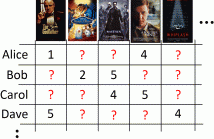- Signal and System Modeling, Representation and Estimation
- Multirate Signal Processing
- Sampling and Reconstruction
- Nonlinear Systems and Signal Processing
- Filter Design
- Adaptive Signal Processing
- Statistical Signal Processing
Matrix completion refers to the recovery of a low‐rank matrix from only a subset of its possibly noisy entries, and has a variety of important applications such as collaborative filtering, image inpainting and restoration, system identification, node localization and genotype imputation. It is because many real-world signals can be approximated by a matrix whose rank is much smaller than the row and column numbers. Most techniques for matrix completion in the literature assume Gaussian noise and thus they are not robust to outliers.
- Categories:
 426 Views
426 Views- Read more about Multiband TDOA Estimation from Sub-Nyquist Samples with Distributed Sensing Nodes
- Log in to post comments
- Categories:
 16 Views
16 Views- Read more about TIME SAMPLES SELECTION IN SPIRAL ACQUISITION FOR SPARSE MAGNETIC RESONANCE SPECTROSCOPIC IMAGING
- Log in to post comments
- Categories:
 7 Views
7 Views- Read more about Phase Retrieval via Coordinate Descent
- Log in to post comments
Phase retrieval refers to recovery of a signal-of-interest given only the intensity measurement samples and has wide applicability including important areas of astronomy, computational biology, crystallography, digital communications, electron microscopy, neutron radiography and optical imaging. The classical problem formulation is to restore the time-domain signal from its power spectrum observations, although the Fourier transform can be generalized to any linear mappings.
- Categories:
 124 Views
124 Views
Matrix completion aims to find the missing entries from incomplete observations using the low-rank property. Conventional convex optimization based techniques minimize the nuclear norm subject to a constraint on the Frobenius norm of the residual. However, they are not robust to outliers and have a high computational complexity. Different from the existing schemes based on solving a minimization problem, we formulate matrix completion as a feasibility problem.
- Categories:
 484 Views
484 Views- Read more about PARTICLE PHD FILTER BASED MULTI-TARGET TRACKING USING DISCRIMINATIVE GROUP-STRUCTURED DICTIONARY LEARNING
- Log in to post comments
Structured sparse representation has been recently found to achieve better efficiency and robustness in exploiting the target appearance model in tracking systems with both holistic and local information. Therefore, to better simultaneously discriminate multi-targets from their background, we propose a novel video-based multi-target tracking system that combines the particle probability hypothesis density (PHD) filter with discriminative group-structured dictionary learning.
- Categories:
 13 Views
13 Views- Read more about An M-Channel Critically Sampled Graph Filter Bank
- Log in to post comments
We investigate an M-channel critically sampled filter bank for graph signals where each of the M filters is supported on a different subband of the graph Laplacian spectrum. We partition the graph vertices such that the mth set comprises a uniqueness set for signals supported on the mth subband. For analysis, the graph signal is filtered on each subband and downsampled on the corresponding set of vertices.
- Categories:
 30 Views
30 Views- Read more about Building Recurrent Networks by Unfolding Iterative Thresholding for Sequential Sparse Recovery
- Log in to post comments
Historically, sparse methods and neural networks, particularly modern deep learning methods, have been relatively disparate areas. Sparse methods are typically used for signal enhancement, compression,and recovery, usually in an unsupervised framework, while neural networks commonly rely on a supervised training set.
- Categories:
 188 Views
188 Views- Read more about NEW ASYMPTOTIC PROPERTIES FOR THE ROBUST ANMF
- Log in to post comments
- Categories:
 4 Views
4 Views